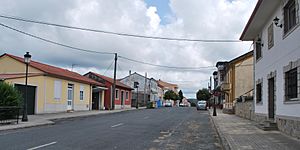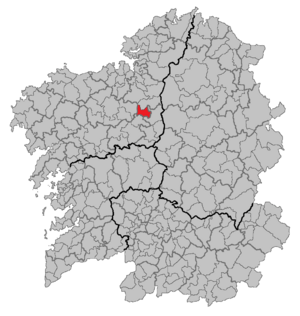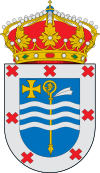Vilasantar facts for kids
Quick facts for kids
Vilasantar
|
||
|---|---|---|
|
municipality
|
||
 |
||
|
||

Location of Vilasantar within Galicia
|
||
| Area | ||
| • Total | 59.36 km2 (22.92 sq mi) | |
| Population
(2018)
|
||
| • Total | 1,225 | |
| • Density | 20.637/km2 (53.449/sq mi) | |
| Time zone | UTC+1 (CET) | |
| • Summer (DST) | UTC+2 (CEST) | |
Vilasantar is a small town in northwestern Spain. It's located in the province of A Coruña, which is part of the region called Galicia. Vilasantar is also part of an area known as the comarca of Betanzos.
Contents
Geography of Vilasantar
Vilasantar is in the southern part of the Betanzos area. It shares borders with several other towns. To the north are Curtis and Oza-Cesuras. To the west is Mesía, and to the east is Sobrado. In the south, it borders Boimorto. The total area of Vilasantar is about 59.2 square kilometers.
Most of Vilasantar is located at a medium height above sea level. The land is usually between 400 and 500 meters high. The Tambre river is very important here. It forms the southern border with Boimorto. Other smaller rivers, like the Cabalar river and the Río das Gándaras river, also flow through the area.
History of Vilasantar
Vilasantar has a long history, with signs of people living there many years ago.
Ancient Times
You can still find very old stone structures called Megaliths. These include the mámoas de Vilariño, the mámoa de Pedriño, and the medorra de Fanegas. These are all in the area of San Vicenzo de Curtis. There are also remains of ancient villages called Castros, like those in Vilariño or As Corredoiras. These belong to the Castro culture, which was common in this part of Spain.
During the time of the Romans, there was a large Roman army camp called Ciadella. It was the biggest Roman camp found in Galicia. This camp was located between Sobrado and Vilasantar.
Middle Ages and Modern Era
In the Middle Ages, the land around Vilasantar was part of the county of Présaras. This county started from Roman times. It was an area of wild land that was given to people to settle and farm. The region was closely connected to two important monasteries: the Sobrado Abbey and the Monastery of Santa María de Mezonzo.
The Monastery of Santa María de Mezonzo might have started during the time of the Suebi, an ancient Germanic people. Its church still has two old stone capitals from the 6th or 7th centuries. In the mid-10th century, Pedro de Mezonzo, who became a leader of the monastery and later a bishop, was connected to this place.
In more recent history, during the Modern Age, many noble families lived in Vilasantar. You can see this from the several large manor houses still present. Vilasantar officially became a town in 1834. Its population grew until about 1950. After that, many people moved away, causing the population to decrease.
Recent History
Vilasantar was a very active place during the Spanish Civil War and the years that followed. In 1938, the mayor of Vilasantar, Antonio Iglesias Corral, was sadly killed. After the war, some groups who resisted the government were active in the area. Famous figures like Foucellas hid in Vilasantar. Another important person from this time, Manolito Bello, was born in the Mezonzo area.
Economy of Vilasantar
The economy of Vilasantar mainly relies on two areas. The primary sector includes farming and other basic activities. The tertiary sector involves services like shops and tourism.
In the secondary sector, making wooden boards is very important. This is because the Losán Group, a large company that makes wood products, has a presence in Vilasantar.
In the early 1900s, the textile industry was also very big here. The La Arzuana factory in Présaras was a major employer. It was started by Luís Miranda and José Núñez de la Barca. Hundreds of people worked there, mostly women, making fabrics.
Population of Vilasantar
The National Institute of Statistics reported that Vilasantar had 1,241 people living there in 2017.
Here's how the population has changed over the last century:

Parishes of Vilasantar
The municipality of Vilasantar is made up of seven smaller areas called parishes. Each parish has its own name and a patron saint.
- Armental (San Martiño)
- Barbeito (San Salvador)
- Mezonzo (Santa María)
- Présaras (San Pedro)
- San Vicenzo de Curtis (San Vicenzo)
- Vilariño (Santa María)
- Vilasantar (Santiago)
Images for kids
See also
 In Spanish: Vilasantar para niños
In Spanish: Vilasantar para niños




